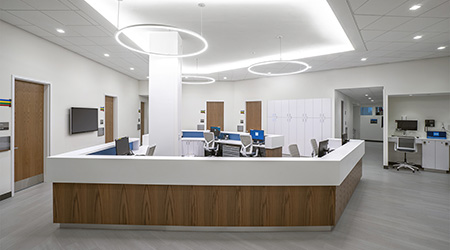It has been a challenging 20 months for the healthcare industry, and burnout among employees is on the rise. With longer hours and more patients than ever, it is harder for healthcare staff to maintain everything on their plates. With traditional hospital layouts, areas such as break rooms, staff lockers and elevators are not easily accessible and take healthcare teams farther from their patients in the event of a medical emergency.
Designers are now looking toward open layouts that move many major touchpoints into hubs that connect to patient wings. In doing so, this strategy can distribute care teamwork areas along the patient wings, benefitting both parties.
“This past year has shown us the increased value of skilled and dedicated healthcare workers,” says Al Thompson, managing executive/studio director, TPG Architecture. “Having an increase in break out spaces so staff can recover physically and emotionally is paramount to support and will help increase productivity.”
Still, the shift to open layouts has been slow, Thompson says. The layouts can provide flexibility to treat patients, but that benefit can be at the expense of privacy and functionality of specialty equipment. Meanwhile, open layouts also depend on the patient’s condition, but there are still physical and mental benefits from the employee side.
“Typically, staff lounges and other break out areas are the last spaces, and the smallest by square footage, that are planned into the design,” Thompson says. “For healthcare workers working 12-hour shifts and being on their feet constantly, not having significant lounge areas available puts additional stress on staff. This is now changing in design and becoming a priority”
While some layout trends might be on the backburner due to the pandemic, technology is being prioritized throughout hospitals and other healthcare facilities. With COVID-19 infections still on the rise, hospitals and other healthcare facilities are implementing emerging technologies to limit high-touchpoint areas in the admission and discharge processes, Thompson says. Meanwhile, telemedicine is also helping reduce the number of in-person visits by enabling appointments online.
“Most of these trends are beneficial to employees and patients,” Thompson says. “Technology is and will continue to be a key driver. Contactless digital check in and check out is beneficial for the patients and relieves staff of this tedious clerical work. Telemedicine, diagnostic equipment and the advancement of AI will greatly improve patient diagnostics and patient outcomes.”
As infrastructure changes, adding trendier designs, such as an open layout, and more technologies into new construction will be easier, Thompson explains.
“Trends and supporting infrastructure changes are easier to implement in new construction projects,” Thompson says. “With some added cost and longer construction durations they are also being implemented in renovation projects.”
Mackenna Moralez — mackenna.moralez@tradepress.com — is assistant editor with Healthcare Facilities Today.

 What Every EVS Leader Needs To Know
What Every EVS Leader Needs To Know Blackbird Health Opens New Clinic in New Jersey
Blackbird Health Opens New Clinic in New Jersey St. John's Riverside Hospital Falls Victim to Data Breach
St. John's Riverside Hospital Falls Victim to Data Breach Grounding Healthcare Spaces in Hospitality Principles
Grounding Healthcare Spaces in Hospitality Principles UC Davis Health Selects Rudolph and Sletten for Central Utility Plant Expansion
UC Davis Health Selects Rudolph and Sletten for Central Utility Plant Expansion